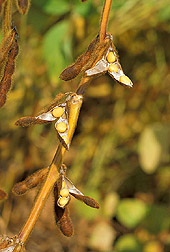This page has been archived and is being provided for reference purposes only. The page is no longer being updated, and therefore, links on the page may be invalid.
Watering Plants When Their Temperature Says, "I'm Thirsty!"By Don ComisAugust 27, 2004 This summer, soybeans growing in a 13-acre circle in Texas are getting water only when they ask for it. Steven R. Evett, an Agricultural Research Service soil scientist, and R. Troy Peters, a post-doctoral researcher in irrigation engineering--based at the ARS Conservation and Production Research Laboratory in Bushland, Texas--are evaluating a way to irrigate crops automatically by taking their temperature. The system is based on "Time-Temperature Thresholds" determined by ARS Cropping Systems Research Laboratory scientists in nearby Lubbock. ARS plant physiologists John J. Burke and James R. Mahan of the Lubbock lab first theorized that each crop has its own optimal temperature for yield. With the experimental system, if plant temperatures stay above optimum for a certain length of time, a cooling irrigation is automatically triggered. Evett has had great success with temperature-guided drip irrigation for corn and soybeans, achieving higher yields for soybeans and greater water use efficiency for corn, than when these crops were watered based on soil moisture. Evett and Peters are now testing the system with center pivot irrigation. The irrigation pipe rotates like the hour hand of a clock, tracing a large circle every 24 to 72 hours as it sprinkles water. This "hour-hand" pipe can be as long as one-half mile. Evett and Peters are using one that's approximately 400 feet long. It has infrared thermometers placed at regular intervals to read crop temperatures. Stationary infrared thermometers in the field double-check readings. Temperature readings are transferred wirelessly to a computer, which then sends instructions to the center pivot. The scientists are trying to determine how this fully automated system affects crop yield compared with more traditional irrigation scheduling. Next year, they will evaluate automated center pivot irrigation of cotton. Eventually they will go beyond merely turning water on and off automatically, moving to a system that can precisely vary water applications in a field where there are different soil types, or two or three different crops growing. ARS is the U.S. Department of Agriculture's chief scientific research agency. |

